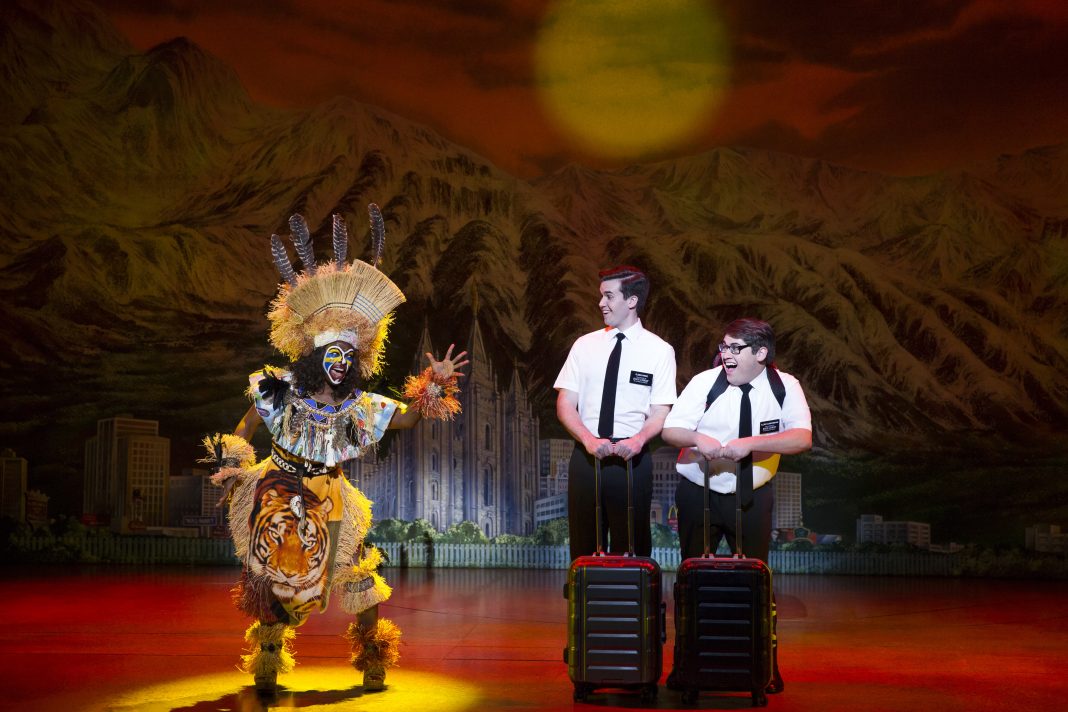By Lynda Lacayo
Be prepared to laugh until your tummy aches when those mismatched missionaries, Elder Price and Elder Cunningham, return to the Segerstrom Center for the Arts March 20-April 1. This is the third go-round for “The Book of Mormon” at the Segerstrom Center and yes, it is still as unconventionally funny, quirky, outrageous, and shocking as it was back in 2011 when it won nine Tony Awards including Best Musical. Aside from the controversial humor and satirical shenanigans, there is justification for it winning critical acclaim along with awards. The show that the New York Times called the best musical of the century is filled with catchy tunes, energetic dancing, and underneath the parody is a positive message of real truths about human nature.
Sterling Jarvis, who plays Ugandan Tribal Chief Mafala Hatimbi, cautions fans of the musical to come with an open mind. He says, “Just follow the story, everything is there for a reason, not just gratuitously. We aren’t swearing and saying bad things just for the sake of it.”
He continues, “This show is the funniest thing I’ve ever done. Every single song in the musical is comical. It’s pretty amazing to be having so much fun. Seeing and hearing the reaction from the audience is rewarding and so uplifting. It’s a great feeling to have as an artist.”
“The Book of Mormon” is a barrel of belly laughs and while religious junkies and the Mormon Anti-Defamation League may take offense at the barnyard humor and tongue-in-cheek mockery of Mormonism, it isn’t blasphemous. On the contrary, it’s an insightful look at the nature of faith and the way America attempts to stamp its brand on the world. Faithless or faithfully fanatic, audiences of all religious persuasions will be rolling in the aisles when “The Book of Mormon” comes to Town Center Dr. in Costa Mesa. One of the show’s creators, Matt Stone, even goes so far as to call it “an atheist’s love letter to religion.”
Jarvis describes the musical as “a buddy-buddy story about Mormon missionaries and their misadventures in Africa. The innocent proselytizers dreamed of ringing bells in exotic locales but ended up in AIDS-riddled Uganda, where they face famine, oppression, and a hardhearted warlord. The culture shock is immediate. That’s where so much of the humor comes from as they march two by two on their crusade to transform the natives. My character, Chief Mafala Hatimbi, meets and greets them on their arrival and explains what life is really like.”
The show isn’t anti-religious.
“I’m a spiritual person,” Jarvis avows, “but ‘Book of Mormon’ doesn’t conflict with my personal beliefs because as an actor, I keep in mind that I’m playing a role. So, I separate these things, my faith and my role. My character knows there are so many horrible things happening in Africa so when these guys come to Uganda and say, ‘hey, just read our book and everything will be okay’, the natives just look at them and go, ‘Oh really?! Our language may be uncouth and as Ugandans we talk to God a little differently,’ but at the end of the show we all say, ‘Thank you, God.’ That’s why I tell folks to just follow the story because we’re not swearing and saying smutty things just for laughs. Everything is there for a reason and it all makes sense.”
“The Book of Mormon” seems to be without boundaries and there is no denying the risqué nature of the show but then as Trey Parker, co-author of the book, says, “There’s a line that you can cross as long as you have a reason for doing it. If it has a point and it has a genuine story, real characters and emotions, then you can pretty much do whatever you want as long as you’re being truthful.”
Jarvis agrees, saying, “Everything we talk about in ‘Book of Mormon’ is absolutely 100% truthful. The creators aren’t making things up to be inflammatory; the language is just a backdrop for what the Ugandans go through in their daily lives. It’s the arc of the story of how they go from being resentful to being grateful at the end.”
He continues, “I don’t think it goes too far because art is meant to shock, to make people feel something. Yeah, there are some who will go, ‘oh my gosh,’ but if they just stay with the story they see the truth of it and care about the characters and their lives. And that is why the show has had such a long run.”
It’s not surprising that folks react differently to the musical across the country. Some audiences hear the message while others just enjoy the humor and music. As Jarvis puts it, “I’ve done the show for two years and I can honestly say that at every show we have a standing ovation. That says it all. People may be shocked but they are laughing at the same time. They stand at the end because they have gone through every emotion you can think of and it was just a wonderful wild ride and everything they experienced made sense.”
But according to Jarvis, it’s the Mormons who really get it. He says, “When I started the show I hadn’t been to Salt Lake City and I couldn’t believe, once I was there, how they, the Latter-day Saints, understood everything, every subtle comment, every joke, and when we referenced Salt Lake City in the show a big cheer went up. They love the show and even advertise in the program because, as they say, ‘If you liked the musical, you’ll love the book!’”
If “The Book of Mormon” was boom rated by movie biz standards, “X” comes to mind because of the provocative language and imagery. Jarvis disagrees, going so far as to give it a family friendly “R” because, as he says, “The suggested age for the show is 12 and up, but I look out at the audience and see people there with kids as young as seven or eight. After the show, parents bring their kids to the stage door and tell us that they just got an interesting education. The point is that they had fun and, let’s face it, kids today are older than we were at that age and inundated with so much information on TV that there’s not much they haven’t heard before.”
When asked to describe “The Book of Mormon” in one word, Jarvis said, “Hilarious!” And he added, “I guarantee people of all ages will walk away from the show saying, ‘that was one of the best shows I’ve ever seen.’”
“The Book of Mormon” is playing at the Segerstrom Center for the Arts, Segerstrom Hall, March 20-April 1. For tickets and information, visit SCFTA.org or call 714-556-2787.
 The Book of Mormon
The Book of Mormon
Washington, D.C.
November 17, 2017
Photo Credit: Julieta Cervantes









